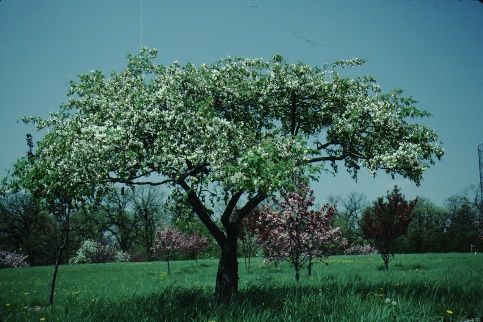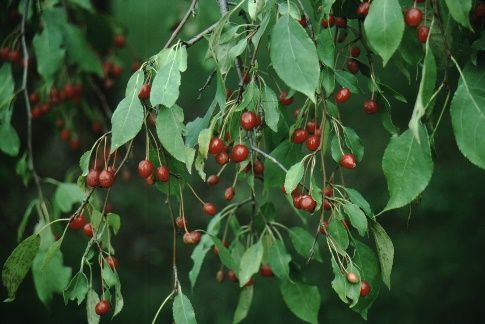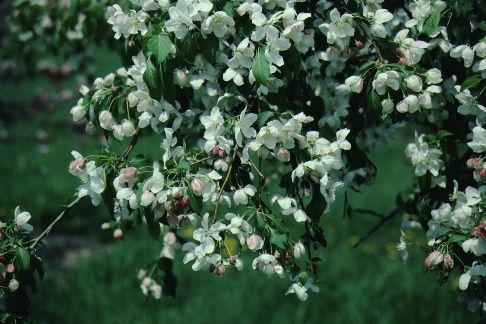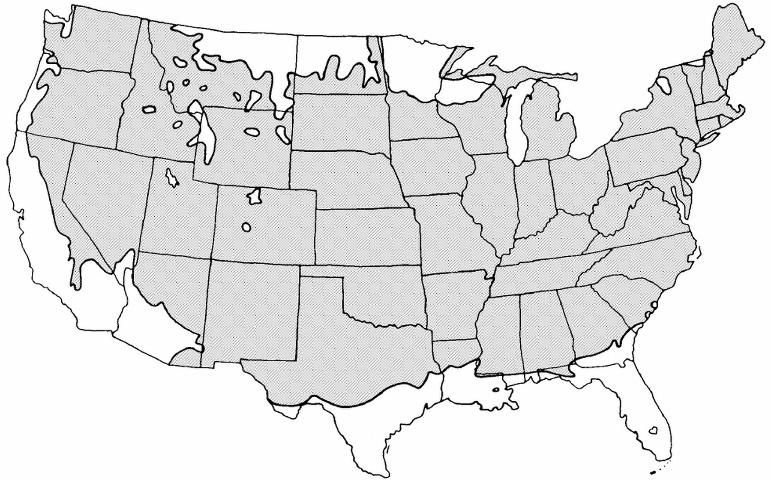Introduction
Crabapples are best grown in a sunny location with good air circulation and have no particular soil preferences, except soil should be well-drained. Root-pruned trees transplant most easily. Tree size, flower color, fruit color, and growth and branching habit vary considerably with the cultivar grown but many grow about 20 feet tall and wide. A few crabapples have good fall color and double-flowered types hold blossoms longer than single-flowered cultivars. Some crabapples are alternate bearers, blooming heavily only every other year. Crabapples are grown for their showy flowers and attractive, brightly colored fruit.

Credit: Edward F. Gilman, UF/IFAS

Credit: Edward F. Gilman, UF/IFAS

Credit: Edward F. Gilman, UF/IFAS
General Information
Scientific name: Malus x 'Red Jade'
Pronunciation: MAY-luss
Common name(s): 'Red Jade' crabapple
Family: Rosaceae
Plant type: tree
USDA hardiness zones: 3B through 8A (Figure 4)
Planting month for zone 7: year round
Planting month for zone 8: year round
Origin: not native to North America
Invasive potential: not known to be invasive
Uses: espalier; trained as a standard; recommended for buffer strips around parking lots or for median strip plantings in the highway; bonsai
Availability: generally available in many areas within its hardiness range

Credit:
Description
Height: 10 to 15 feet
Spread: 15 to 20 feet
Plant habit: weeping
Plant density: moderate
Growth rate: moderate
Texture: medium
Foliage
Leaf arrangement: alternate
Leaf type: simple
Leaf margin: serrate
Leaf shape: elliptic (oval)
Leaf venation: brachidodrome
Leaf type and persistence: deciduous
Leaf blade length: 2 to 4 inches
Leaf color: green
Fall color: yellow
Fall characteristic: not showy
Flower
Flower color: pink
Flower characteristic: showy
Fruit
Fruit shape: round
Fruit length: less than 0.5 inch
Fruit cover: fleshy
Fruit color: red
Fruit characteristic: attracts birds; showy; persists on the plant
Trunk and Branches
Trunk/bark/branches: typically multi-trunked or clumping stems; not particularly showy; no thorns
Current year stem/twig color: brown
Current year stem/twig thickness: medium
Culture
Light requirement: plant grows in full sun
Soil tolerances: clay; acidic; well-drained; sand; loam; alkaline; occasionally wet
Drought tolerance: unknown
Soil salt tolerances: moderate
Plant spacing: not applicable
Other
Roots: usually not a problem
Winter interest: plant has winter interest due to unusual form, nice persistent fruits, showy winter trunk, or winter flowers
Outstanding plant: not particularly outstanding
Pest resistance: very sensitive to one or more pests or diseases which can affect plant health or aesthetics
Use and Management
Plants are used for specimens, patios (small-fruiting types), and along streets to create a warm glow of color each spring. Most are attractive during the summer, bearing glossy green foliage. Popular around overhead power lines due to their small stature, a row of crabapples along each side of the street or median strip can “make” a neighborhood. Select plants that have been grafted onto EMLA 106 or 111 rootstock to reduce root suckering.
Crabapple is well-adapted to compacted urban soil, tolerates drought and poor drainage well, and is somewhat tolerate of salt spray. Well adapted to all areas within its clearance hardiness zone range, including Texas and Oklahoma. Very adaptable tree.
Do not over-fertilize, since this could increase the incidence of disease. Select only from disease-resistant cultivars. Crabapples grow well in the Texas panhandle but are not extremely drought tolerant and are not well suited for high-pH soil.
Large-fruited types can create a maintenance problem because rotting fruits attract insects and rodents and are quite messy. Some crabapples sprout vigorously from the roots, and these will require regular pruning to maintain an attractive tree. Trees used as street trees will require regular pruning early in their life to train lower branches for pedestrian and vehicle clearance.
There are hundreds of crabapple cultivars with single or double, red, pink, or white flowers, and varying fruit size. Many are cultivars of Malus baccata and Malus floribunda. Since disease resistance can vary depending on where a particular cultivar is grown, be sure to choose a cultivar that has been shown to be resistant to disease in your area. Your urban forestry program could suffer if you plant the wrong cultivar, but it could blossom if the correct ones are installed.
Malus adapted for street tree and urban use include 'Adams' 'Bob White', 'David', 'Donald Wyman', 'Profusion', 'Red Splendor', and Malus floribunda. Be sure to specify tree form plants for street tree use, since branching may be too low on trees grown for specimen use.
White flowered cultivars include 'Baccata Columnaris'—narrow crown, white flowers, red or yellow fruit; 'Baccata Gracilis'—slow-growing, shrub-like, white flowers, fruit small and dark red, annual bearer; 'Baccata Jackii'—upright form, white flowers, bright red fruit, annual bearer, also good to excellent disease resistance; 'Callaway'—pink buds, white flowers, red fruit; 'David'—pink buds open to white flowers, scarlet fruit, good to excellent disease resistance; 'Dolgo'—pink buds, white flowers, large red fruits; 'Donald Wyman'—disease-resistant but susceptible to fire blight, glossy red showy fruit; 'Ellwangeriana'—red fruit, disease-resistant; 'Floribunda'—pink to red bud opens to single white flower, yellow or red fruit - commonly available; 'Gloriosa'—pink bud opens to white flower, red, large fruit; 'Golden Hornet'—upright arching habit, white flower, yellow fruit; 'Gorgeous'—pink bud opens to large, white flower, red to orange fruit; 'Harvest Gold'—white flowers followed by yellow fruits; 'Hupehensis'—tea crabapple - pink buds open to white flowers, greenish fruit; 'Katherine'—double flowers opening pink, fading to white, fruit yellow and red; 'Mary Potter'—pink buds open to single white flowers, red and fairly large fruit, susceptible to scab and powdery mildew; 'Red Jade'—weeping habit, white flowers, red fruit persisting after leaves drop; 'Sargenti'—dwarf, pink bud opens to white flowers, small dark red fruit; 'Snowdrift'—white flowers, orange red fruit; 'Tanner'—white flowers, red fruits, susceptible to diseases;'Tschonoski'—white flowers, vigorous growth, good bronze red fall color, fruit brownish; 'White Angel'—white flowers, glossy red fruit persisting into winter; 'White Candle'—pink buds open to white flowers, red fruit, upright growth habit; 'Zumi Calocarpa'—white flowers, bright red persistent fruit.
Pink flowered cultivars include: 'Arnoldiana'—red buds, pale pink to white flowers, red and yellow fruits, susceptible to diseases; 'Barbara Ann'—double pink flowers; 'Beverly'—pink flowers, small, bright red fruit, upright open habit 'Brandywine'—double, pink flowers, foliage tinged reddish; `Candied Apple'—red buds and pink flowers, persistent bright red fruits; 'Coralburst'—pink flowers, a dwarf about eight feet tall; 'Dorothea'—red buds, pink flowers, yellow fruits, susceptible to scab; 'Hopa'—pink flowers, red and yellow fruit, extremely susceptible to scab; 'Margaret'—disease-resistant; 'Mount Arbor Special'—disease-resistant, red fruit; 'Oekonomierath Echtermayer'—somewhat weeping habit, red buds, pink flowers, red fruits; 'Pink Perfection'—pink flowers, susceptible to scab; 'Prairie Rose'—double pink flowers, no fruit; 'Radiant'—red buds, pink flowers, persistent red fruits, susceptible to scab; 'Van Eseltine'—double pink flowers, columnar; 'Velvet Pillar'—upright form, pink flowers, red fruit and purple foliage; 'Weeping Candied Apple'—pink flowers and red fruit on horizontal to pendulous branches.
Cultivars with red flowers include 'American Beauty'—double, red flowers, susceptible to scab; 'Centurion'—a columnar growth habit, red flowers followed by bright red, persistent fruits; 'Indian Magic'—red flowers, maroon fall color, small red fruit, persistent; 'Purpurea Lemoinei'—dark rose color flowers, alternate bearing; 'Profusion'—red flowers and fruit; 'Red Baron'—red flowers, susceptible to scab; 'Red Silver'—red flowers, red fruit, susceptible to scab; 'Red Splendor'—red buds, red to pink flowers, red fruit, susceptible to scab; 'Royal Ruby'—double red flowers, sparse red fruit, susceptible to scab; 'Royalty'—red flowers, red fruits, young foliage purple, susceptible to scab; 'Selkirk'—red flowers, red fruits, susceptible to diseases; 'Sparkler'—red flowers, red fruits; 'Tomiko'—disease-resistant, reddish-purple blooms; 'Wisley'—red flowers.
One of the best crabapples for the south is Malus x 'Callaway'.
Disease-resistant cultivars include 'David', `Dolga', 'Donald Wyman', 'Ellwangeriana', 'Inglis', 'Jackii', 'Jewelberry', 'Margaret', 'Mary Potter', 'Mount Arbor Special', 'Prairifire', 'Professor Sprenger', 'Tomiko'. Contact the Ornamental Crabapple Society, Morton Arboretum, Lisle, Illinois 60532, for more information on crabapples.
Pests and Diseases
Aphids infest branch tips and suck plant juices and are quite common. They can deform newly emerging foliage, and they secrete honeydew, creating a sticky mess beneath the tree, but they will not kill the tree.
Fall webworm makes nests on the branches and feeds on foliage inside the nest. Small nests can be pruned out or sprayed with Bacillus thuringiensis. Controlling severe infestations may require other chemicals.
Scales of various types are controlled with horticultural oil.
Borers can be a problem on stressed trees.
Mites are too small to see easily so they can cause much foliage discoloration before being detected. Mites can be controlled to a degree with horticultural oil, but other chemicals are often required by the time mites are detected. The mite infestation can also be severe by the time foliage chlorosis or bronzing is evident.
Eastern tent caterpillar builds tents or nests in trees in early summer or late spring. Feeding occurs on foliage outside the nest. Defoliation can be extensive if infestation is severe, and repeated defoliations for several years can weaken trees. Small nests can be removed by pruning them from the tree. Spray with Bacillus thuringiensis or another approved chemical. Do not burn nests while they are still in the tree.
Many selections are fairly susceptible to disease. Select from the disease-resistant ones.
Scab infection takes place early in the season, and dark olive -green spots appear on the leaves. In late summer the infected leaves fall off when they turn yellow. Infected fruits have black, slightly raised spots. Use resistant varieties to help avoid this severe problem.
Fire-blight-susceptible trees have blighted branch tips, particularly when the tree is growing rapidly. Leaves on infected branch tips turn brown or black, droop, and hang on the branches. The leaves look scorched, as if by a fire. The trunk and main branches become infected when the bacteria are washed down the branches. Cankers form and are separated from adjacent healthy bark by a crack. The infected bark may be shredded. Use resistant cultivars when available since severe infections on susceptible trees can kill the tree.
Powdery mildew coats leaves with white fungal growth resembling powder.
Cedar apple rust causes brown to rusty-orange spots on the leaves. Badly spotted leaves fall prematurely, and defoliation can be heavy. Red cedars (Juniperus virginiana) are the alternate host.
Crabapples are subject to several canker diseases. Prune out infected branches, avoid unnecessary wounding, and keep trees healthy.